1. Other pages in this release
This month we have introduced an estimate of the public sector debt interest to revenue ratio (DIR) for the first time. DIR in the financial year ending March 2019 currently stands at 4.1%, which is 1.9 percentage points below the 6.0% level set by the government. DIR data are available in Table PSA4 of this release.
Explanations of this indicator and the two additional fiscal rules introduced in Budget 2020 are available in the article Recent and upcoming changes to public sector finance statistics.
Back to table of contents2. Main points
Borrowing (public sector net borrowing excluding public sector banks, PSNB ex) in February 2020 was £0.3 billion, £0.3 billion less than in February 2019.
Borrowing in the current financial year-to-date (April 2019 to February 2020) was £44.0 billion, £4.2 billion more than in the same period the previous year.
The current budget deficit (public sector current budget deficit excluding public sector banks) in the current financial year-to-date was £2.4 billion, £0.4 billion less than in the same period the previous year.
Debt (public sector net debt excluding public sector banks, PSND ex) at the end of February 2020 was £1,791.5 billion (or 79.1% of gross domestic product, GDP); this is an increase of £32.1 billion (or a decrease of 1.1 percentage points) on February 2019.
Central government net cash requirement excluding both UK Asset Resolution Ltd and Network Rail was £35.2 billion in the current financial year-to-date; this is £20.4 billion more than in the same period last year.
4. Borrowing in February 2020
After a January surplus, borrowing in February is relatively low, again largely because of the strength of self-assessed income tax over this period. During the first 11 months of the current financial year, borrowing has tracked above that in the same period last year.
Figure 1: The Office for Budget Responsibility expects borrowing to increase to £47.4 billion in the financial year ending March 2020
Public sector net borrowing excluding public sector banks, UK, cumulative financial year-to-date (April 2019 to February 2020) compared with the financial year ending March 2019 (April 2018 to March 2019)
Source: Office for National Statistics – Public sector finances
Notes:
- The Office for Budget Responsibility (OBR) full financial year forecast of PSNB ex for the FYE 2020, taken from the March 2020 Economic and fiscal outlook.
Download this chart Figure 1: The Office for Budget Responsibility expects borrowing to increase to £47.4 billion in the financial year ending March 2020
Image .csv .xlsOn 11 March 2020, the government published a Budget. The Budget, or Financial Statement, is a statement made by the Chancellor of the Exchequer on the nation’s finances and the government’s proposals for changes to taxation and spending. In its Economic and Fiscal Outlook (EFO) for March 2020, the OBR has reduced its forecast of public sector net borrowing for the financial year ending (FYE) March 2020, from £47.6 billion to £47.4 billion.
Figure 2 summarises how each of the five sub-sectors (central government, local government, non-financial public corporations, public sector pensions and the Bank of England (BoE)) contribute to the overall growth in monthly borrowing in February 2020 and compares this with the equivalent measures in the same month a year earlier (February 2019).
Figure 2: Public sector net borrowing excluding public sector banks by sub-sector, UK, February 2020 compared with February 2019
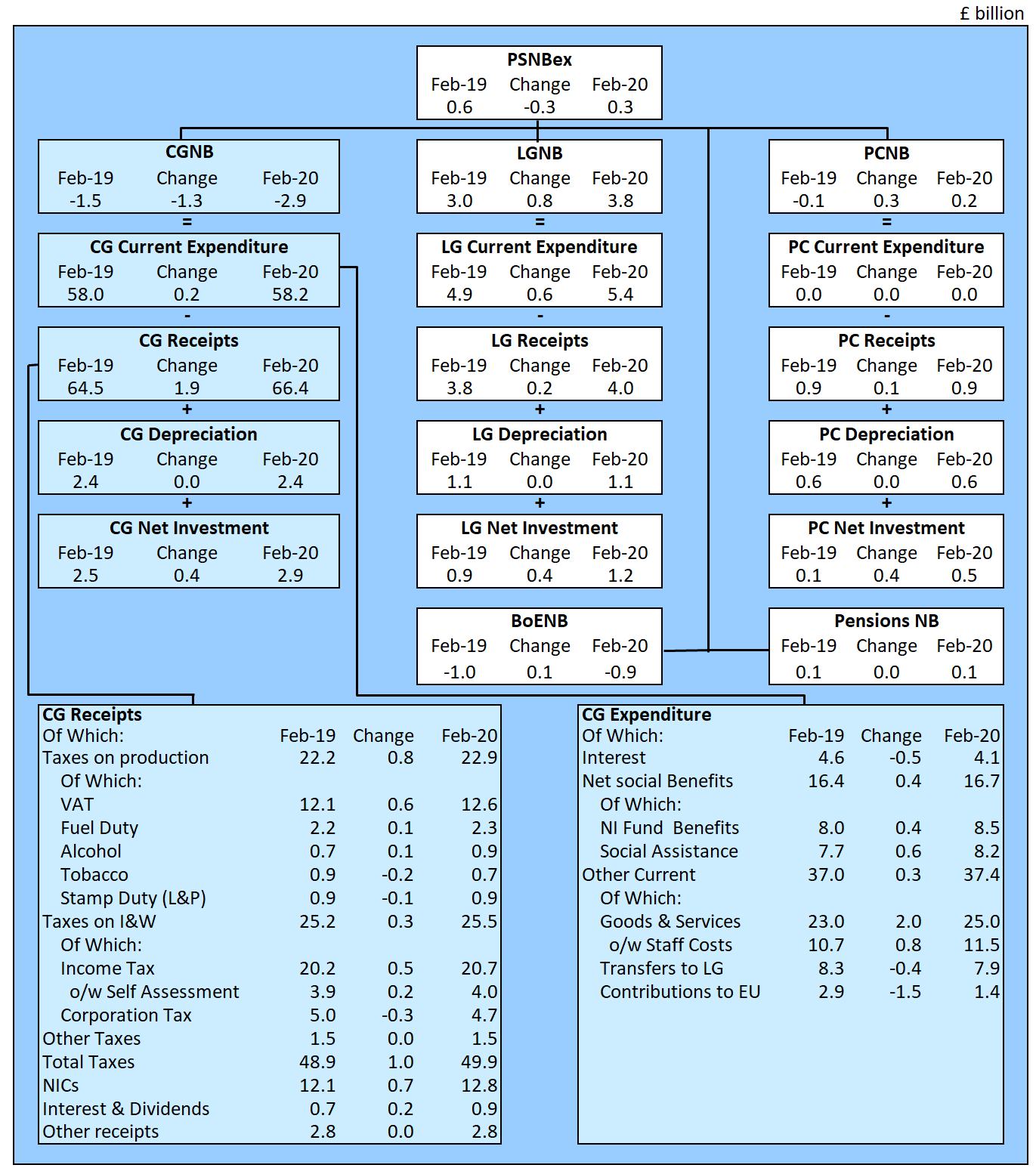
Source: Office for National Statistics – Public sector finances
Notes:
- PSNB ex – Public sector net borrowing excluding public sector banks.
- CGNB – Central government net borrowing.
- LGNB – Local government net borrowing.
- PCNB – Non-financial public corporations' net borrowing.
- BoENB – Bank of England net borrowing.
- L&P – Land and property.
- I&W – Income and wealth.
- NICs – National Insurance contributions.
- Contributions to EU – UK VAT, GNI and abatement contributions to the EU budget.
- o/w – Of which.
Download this image Figure 2: Public sector net borrowing excluding public sector banks by sub-sector, UK, February 2020 compared with February 2019
.png (133.5 kB) .xls (96.3 kB)In February 2020, the public sector spent more money than it received in taxes and other income. Over this period, the public sector borrowed £0.3 billion, £0.3 billion less than it had to borrow in February 2019.
The difference between central government’s income and spending makes the largest contribution to the amount borrowed by the public sector.
In February 2020, while central government was in surplus by £2.9 billion, local government and public corporations borrowed £3.8 billion and £0.2 billion respectively.
Additionally, the BoE’s contribution to net borrowing was a surplus of £0.9 billion.
Central government receipts
In February 2020, central government receipts grew by 3.0% compared with February 2019 to £66.4 billion, including £49.9 billion in tax revenue.
Self-assessed Income Tax
Each January and February, central government receipts are particularly high because of the receipt of self-assessed Income Tax and Capital Gains Tax cash payments.
Combined self-assessed Income Tax and Capital Gains Tax receipts in February 2020 were £6.0 billion, equal to that recorded in February 2019.
The proportion of self-assessed taxes recorded in January and February can vary year-on-year and it is therefore advisable to consider data for the two months (January and February) together.
Combined self-assessed Income Tax and Capital Gains Tax receipts in January and February 2020 (together) were £28.8 billion, an increase of £1.3 billion compared with the same two months in 2019; this is the highest on record (records began in January 2000).
Central government expenditure
In February 2020, central government spent £61.1 billion, an increase of 1.0% on February 2019. Of this amount, around two-thirds was spent by central government on providing services and grants (for example, related to education, defence, and health and social care); just below one-third was spent on social benefits (such as pensions, unemployment payments, Child Benefit and Statutory Maternity Pay); and the remainder was spent on capital investment and interest on the government’s outstanding debt.
Departmental expenditure on goods and services
Departmental expenditure on goods and services in February 2020 increased by £2.0 billion compared with February 2019, including a £0.8 billion increase in expenditure on staff costs and a £1.1 billion increase in the purchase of goods and services. This increase in pay and procurement partially reflects that we have entered the first of the five years covered by the Department of Health and Social Care (DHSC) spending settlement.
UK contributions to the EU
The UK contribution to the EU in February 2020 was £1.4 billion, a decrease of £1.5 billion on February 2019. This decrease is largely because of the profile of 2020 payments made to the EU by all member states (and the UK) rather than a reflection of any budgetary change, and follows the increase of £1.1 billion observed last month compared with January 2019.
Monthly transactions are often affected by the timings of payments and so caution should be taken when drawing conclusions from monthly data.
Interest payments on the government’s outstanding debt
Interest payments on the government’s outstanding debt in February 2020 were £4.1 billion, a decrease of £0.5 billion, compared with February 2019. Changes in debt interest are largely a result of movements in the Retail Prices Index (RPI) to which index-linked bonds are pegged.
Back to table of contents5. Borrowing in earlier periods
Given the volatility of the monthly data, the cumulative financial year-to-date borrowing figures often provide a better indication of the position of the public sector finances than the individual months’ figures.
Across the first 11 months of the current financial year-to-date, the public sector borrowed a total of £44.0 billion, £4.2 billion (or 10.4%) more than in the same period last year.
Figure 3 summarises how each of the five sub-sectors (central government, local government, non-financial public corporations, public sector pensions and the Bank of England (BoE)) contribute to the overall growth in monthly public sector net borrowing excluding public sector banks (PSNB ex) in the current financial year-to-date and compares this with the equivalent measures in the same period last year (April 2018 to February 2019).
Figure 3: How each sector contributes to the growth in borrowing
Public sector net borrowing by sub-sector, UK, current financial year-to-date (April 2019 to February 2020) compared with the same period last year
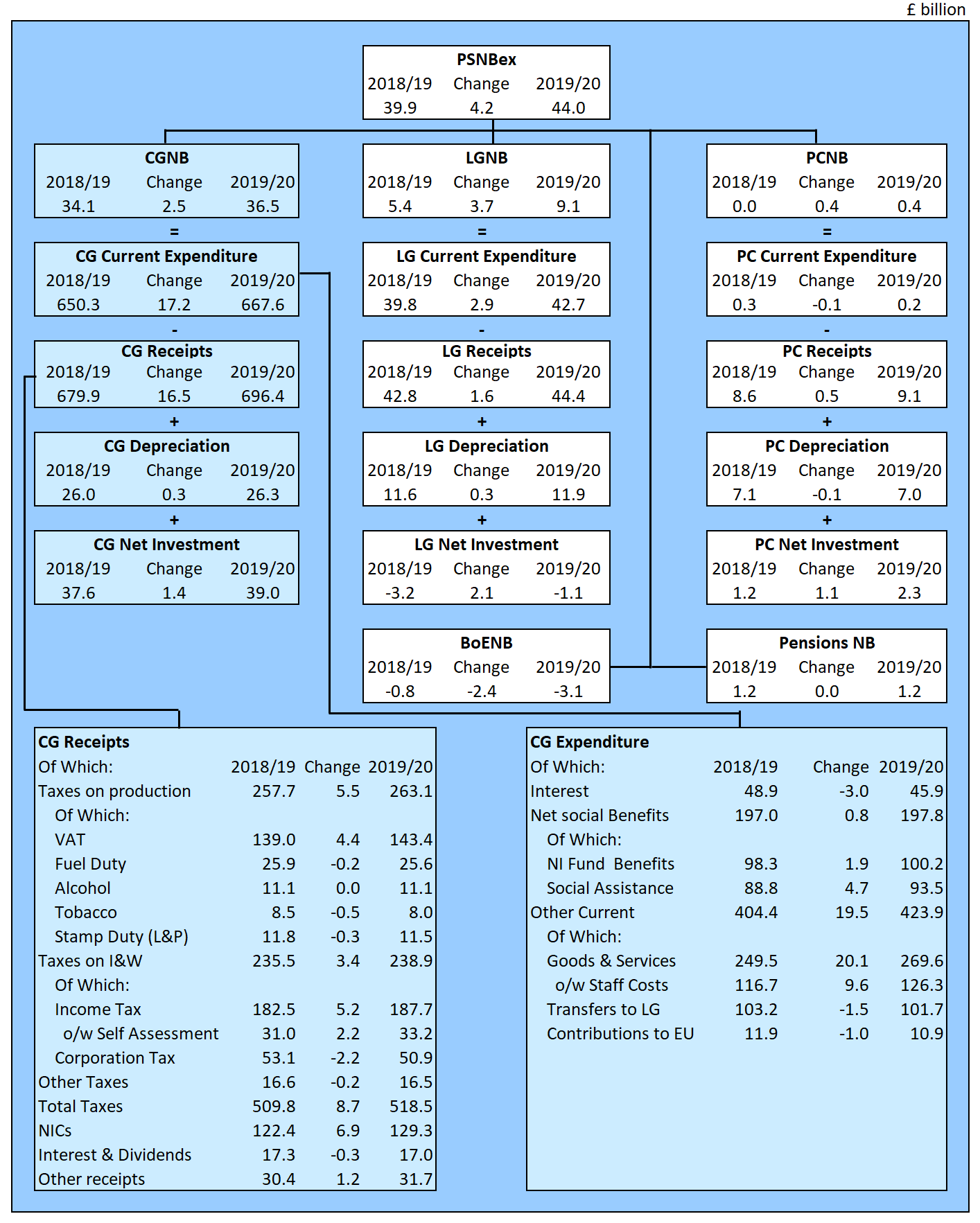
Source: Office for National Statistics – Public sector finances
Notes:
- PSNB ex – Public sector net borrowing excluding public sector banks.
- CGNB – Central government net borrowing.
- LGNB – Local government net borrowing.
- PCNB – Non-financial public corporations' net borrowing.
- BoENB – Bank of England net borrowing.
- L&P – Land and property.
- I&W – Income and wealth.
- NICs – National Insurance contributions.
- Contributions to EU – UK VAT, GNI and abatement contributions to the EU budget.
- o/w – Of which.
Download this image Figure 3: How each sector contributes to the growth in borrowing
.png (148.3 kB) .xls (86.5 kB)In the latest full financial year (April 2018 to March 2019), the £38.9 billion (or 1.8% of gross domestic product (GDP)) borrowed by the public sector was around one-quarter (24.6%) of the amount seen in the financial year ending (FYE) March 2010, when borrowing was £158.3 billion (or 10.2% of GDP).
Figure 4: Borrowing has generally been falling since its peak in the financial year ending 2010
Public sector net borrowing excluding public sector banks, UK, April 1993 to February 2020
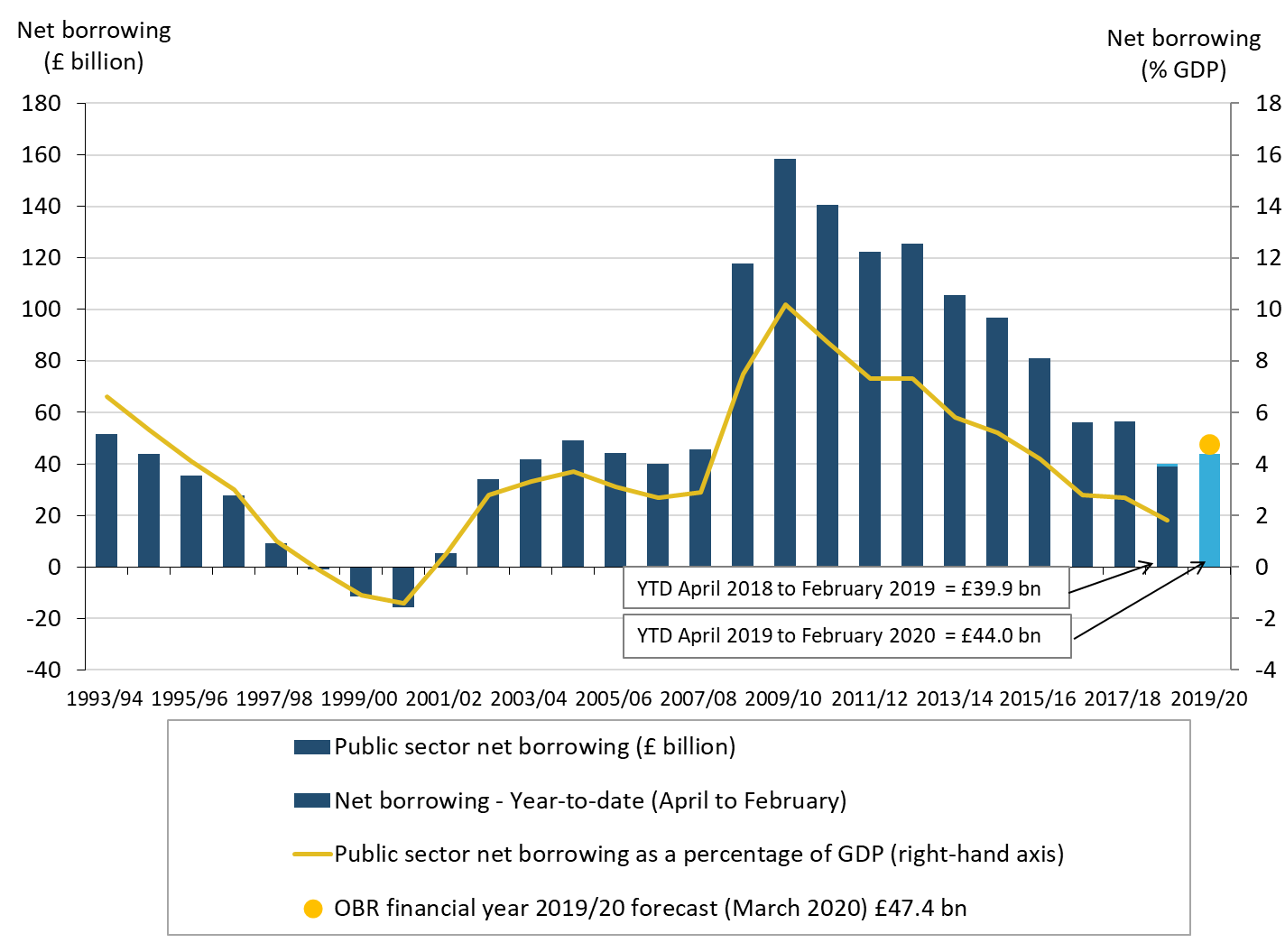
Source: Office for National Statistics – Public sector finances
Notes:
- The Office for Budget Responsibility (OBR) full financial year forecast of PSNB ex for the FYE 2020, taken from the March 2020 Economic and fiscal outlook.
- Financial year 2018/19 represents the financial year ending 2019 (April 2018 to March 2019).
- YTD equals year-to-date (April to February).
Download this image Figure 4: Borrowing has generally been falling since its peak in the financial year ending 2010
.png (83.8 kB) .xls (86.0 kB)6. Debt
At the end of February 2020, the amount of money owed by the public sector to the private sector stood at approximately £1.8 trillion (or £1,791.5 billion), which equates to 79.1% of gross domestic product (GDP). Though debt has increased by £32.1 billion on February 2019, the ratio of debt to GDP has decreased by 1.1 percentage points, as UK GDP has grown at a faster rate than debt over this period.
When the government borrows, this normally adds to the total debt, but it is important to remember that reducing the deficit is not the same as reducing the debt.
Figure 5: Debt as a percentage of gross domestic product (GDP) has been falling in recent financial years
Public sector net debt (excluding public sector banks), UK, March 1994 to the end of February 2020
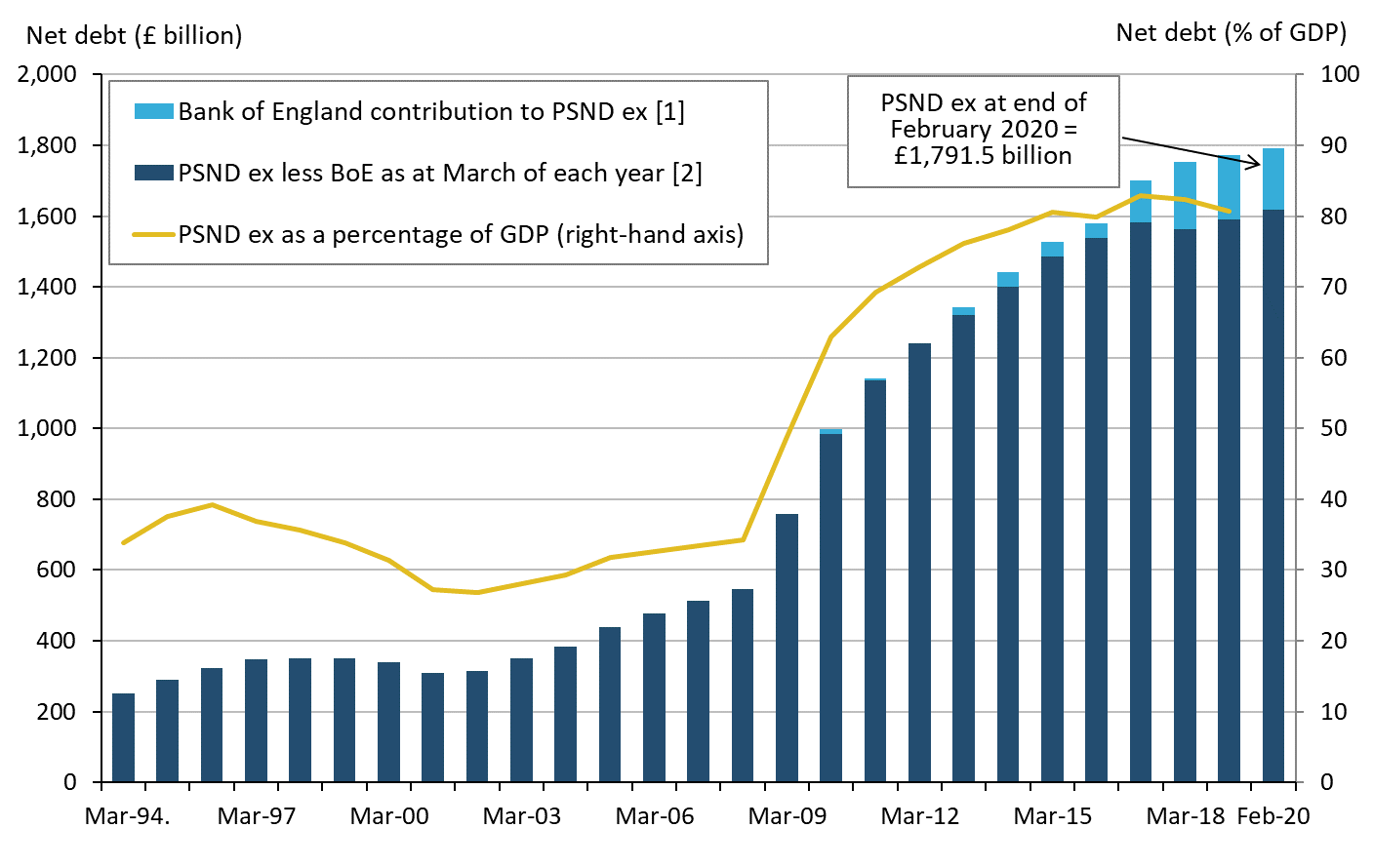
Source: Office for National Statistics – Public sector finances
Notes:
- Includes Asset Purchase Facility (APF), which includes the Term Funding Scheme (TFS).
- PSND ex is the combination of PSND ex Bank of England plus Bank of England. contribution to PSND ex.
- Public sector net debt excluding public sector banks (PSND ex) shown at the end of each financial year (March), unless otherwise stated.
Download this image Figure 5: Debt as a percentage of gross domestic product (GDP) has been falling in recent financial years
.png (71.1 kB) .xls (73.7 kB)Debt at the end of February 2020 excluding the Bank of England (BoE) (mainly quantitative easing) was £1,617.6 billion (or 71.4% of GDP); this is an increase of £45.6 billion (or a decrease of 0.3 percentage points) on February 2019.
Back to table of contents7. Revisions
Table 1 shows the revisions to the headline statistics presented in this bulletin compared with those presented in the previous bulletin (published on 21 February 2020), while Figure 6 shows how each element of the public sector contributes to the revision in the current financial year-to-date net borrowing (public sector net borrowing excluding public sector banks, PSNB ex).
The data for the latest months of every release contain a degree of forecasts, subsequently these are replaced with improved forecasts as further data are available and finally outturn. The revisions presented in this section are largely the result of new tax and central government expenditure data received from our data suppliers.
| £ billion¹ (not seasonally adjusted) | |||||||||
|---|---|---|---|---|---|---|---|---|---|
| Net borrowing | |||||||||
| Period | CG² | LG³ | NFPCs⁴ | PSP⁵ | BoE⁶ | PSNB ex⁷ | PSND ex⁸ | PSND % of GDP⁹ | PSNCR ex¹⁰ |
| 2016/17 | 0.0 | 0.0 | 0.0 | 0.0 | 0.0 | 0.0 | 0.0 | 0.0 | 0.0 |
| 2017/18 | 0.0 | 0.0 | 0.0 | 0.0 | 0.0 | 0.0 | 0.0 | 0.0 | 0.0 |
| 2018/19 | 0.3 | 0.2 | 0.1 | 0.0 | 0.0 | 0.5 | 0.0 | 0.0 | 0.0 |
| 2019/20 y-t-d¹² | 0.8 | -1.7 | -0.3 | 0.0 | 0.0 | -1.1 | -4.4 | -0.1 | -0.4 |
| 2019 Apr | 0.1 | -0.2 | 0.0 | 0.0 | 0.0 | -0.1 | -0.6 | 0.0 | 0.0 |
| 2019 May | 0.0 | -0.2 | 0.0 | 0.0 | 0.0 | -0.2 | -0.6 | 0.0 | 0.0 |
| 2019 Jun | 0.0 | -0.2 | 0.0 | 0.0 | 0.0 | -0.2 | -0.6 | 0.0 | 0.0 |
| 2019 Jul | 0.2 | 0.0 | 0.0 | 0.0 | 0.0 | 0.2 | -0.6 | 0.0 | 0.0 |
| 2019 Aug | 0.3 | 0.0 | 0.0 | 0.0 | 0.0 | 0.3 | -0.6 | 0.0 | 0.0 |
| 2019 Sep | 0.3 | 0.0 | 0.0 | 0.0 | 0.0 | 0.3 | -0.6 | 0.0 | 0.0 |
| 2019 Oct | 1.0 | -0.5 | -0.1 | 0.0 | 0.0 | 0.3 | -1.7 | -0.1 | 0.0 |
| 2019 Nov | 0.2 | 0.0 | -0.1 | 0.0 | 0.0 | 0.1 | -2.8 | -0.1 | 0.0 |
| 2019 Dec | 0.2 | 0.0 | -0.1 | 0.0 | 0.0 | 0.1 | -3.8 | -0.2 | 0.0 |
| 2020 Jan | -1.5 | -0.4 | 0.1 | 0.0 | 0.0 | -1.9 | -4.4 | -0.1 | -0.4 |
Download this table Table 1: Revisions to main aggregates
.xls .csv
Figure 6: How each element of the public sector contributes to the revision in financial year-to-date net borrowing (PSNB ex)
Latest data covering the months of April to January 2020, compared with that presented in the previous bulletin (published on 21 February 2020), UK
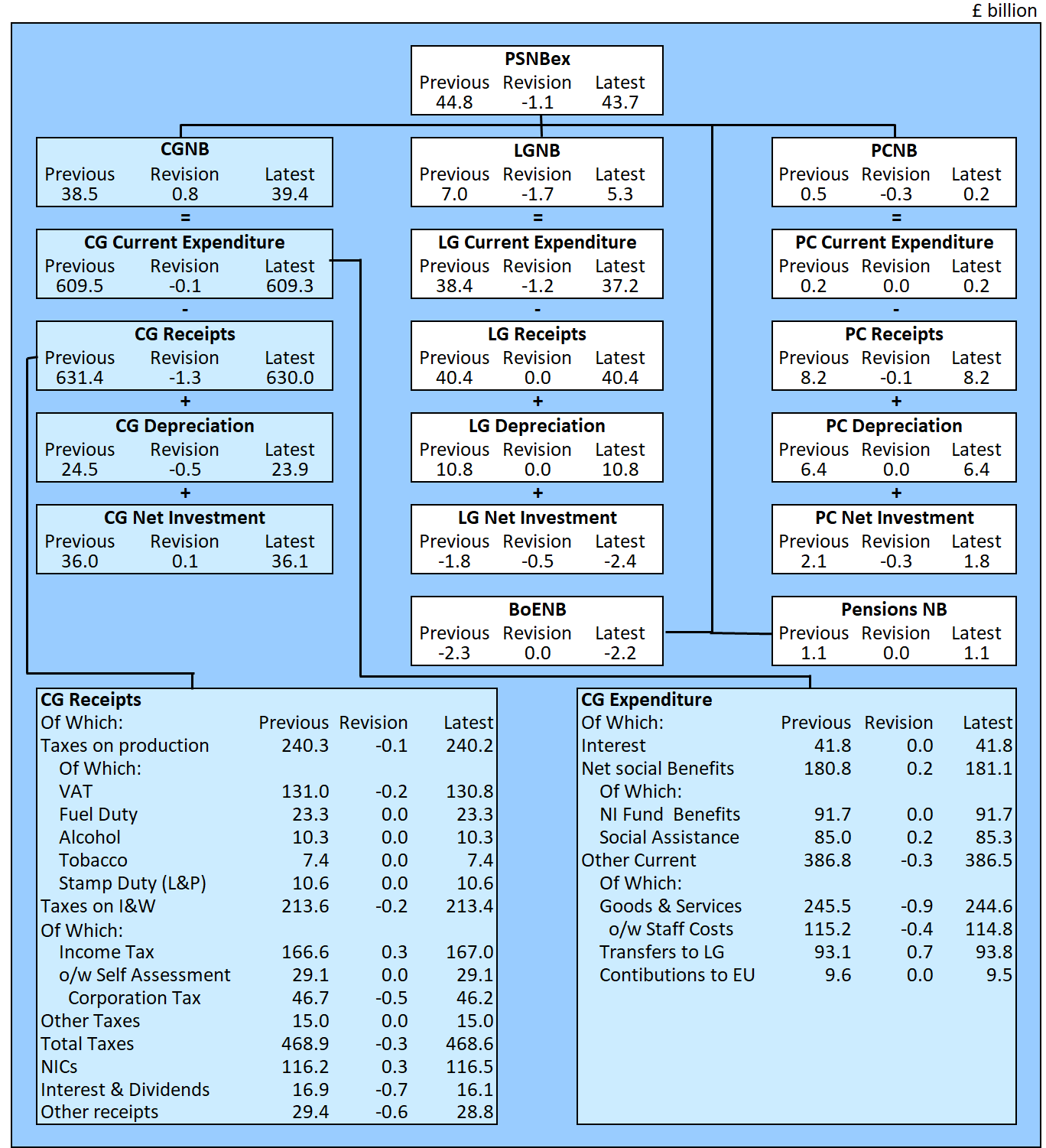
Source: Office for National Statistics – Public sector finances
Notes:
- PSNB ex – Public sector net borrowing excluding public sector banks.
- CGNB – Central government net borrowing.
- LGNB – Local government net borrowing.
- PCNB – Non-financial public corporations' net borrowing.
- BoENB – Bank of England net borrowing.
- L&P – Land and property.
- I&W – Income and wealth.
- NICs – National insurance contributions.
- Contributions to EU – UK VAT, GNI and abatement contributions to the EU budget.
- o/w – Of which.
Download this image Figure 6: How each element of the public sector contributes to the revision in financial year-to-date net borrowing (PSNB ex)
.png (133.5 kB) .xls (96.3 kB)In the current financial year-to-date, upward revisions to current transfers from central to local government have increased central government net borrowing by £0.7 billion and reduced local government net borrowing by an equivalent amount.
Back to table of contents8. Public sector finances data
Public sector finances borrowing by sub-sector
Dataset | Released 23 March 2020
An extended breakdown of public sector borrowing in a matrix format and estimates of total managed expenditure (TME).
Public sector finances tables 1 to 10: Appendix A
Dataset | Released 20 March 2020
The data underlying the public sector finances statistical bulletin are presented in the tables PSA 1 to 10.
Public sector finances revisions analysis on main fiscal aggregates: Appendix C
Dataset | Released 20 March 2020
Revisions analysis for central government receipts, expenditure, net borrowing and net cash requirement statistics for the UK over the last five years.
Public sector current receipts: Appendix D
Dataset | Released 20 March 2020
A breakdown of UK public sector income by latest month, financial year-to-date and full financial year, with comparisons with the same period in the previous financial year.
Impact of student loans, public sector-funded pension scheme changes and capital consumption changes introduced in September 2019: Appendix G
Dataset | Released 20 March 2020
Latest estimates of PSNB (and further into current budget deficit and net investment spending), net debt and net financial liabilities, with the impacts of changes to the accounting for student loans, public sector pensions and capital consumption introduced in September 2019.
All datasets related to this publication are available on our website.
9. Glossary
The public sector
In the UK, the public sector consists of six subsectors: central government, local government, public non-financial corporations, public sector pensions, the Bank of England (BoE) and public financial corporations (or public sector banks).
Public sector current budget deficit
Public sector current budget is the difference between revenue (mainly from taxes) and current expenditure, on an accrued basis; it is the gap between current expenditure and current receipts (having taken account of depreciation). The current budget is in surplus when receipts are greater than expenditure.
Public sector net investment
Net investment refers to the balance of acquisition less disposals of capital assets and liabilities.
Public sector net borrowing
Public sector net borrowing excluding public sector banks (PSNB ex) measures the gap between revenue raised (current receipts) and total spending (current expenditure plus net investment (capital spending less capital receipts)). Public sector net borrowing (PSNB) is often referred to by commentators as “the deficit”.
Public sector net cash requirement
The public sector net cash requirement (PSNCR) represents the cash needed to be raised from the financial markets over a period of time to finance the government’s activities. This can be close to the deficit for the same period; however, there are some transactions, for example, loans to the private sector, that need to be financed but do not contribute to the deficit. It is also close but not identical to the changes in the level of net debt between two points in time.
Public sector net debt
Public sector net debt excluding public sector banks (PSND ex) represents the amount of money the public sector owes to private sector organisations including overseas institutions, largely as a result of issuing gilts and Treasury Bills, minus the amount of cash and other short-term assets it holds. Public sector net debt (PSND) is often referred to by commentators as “the national debt”.
Debt interest to revenue ratio
The debt interest to revenue ratio (DIR) represents the proportion of net interest paid (gross interest paid less interest received) by the public sector (excluding public sector banks), compared with the non-interest receipts it receives in a given period.
Other important terms commonly used to describe public sector finances are listed in the Public sector finances glossary.
Back to table of contents10. Measuring the data
The Monthly statistics on the public sector finances: a methodological guide provides comprehensive contextual and methodological information concerning the monthly public sector finances statistical bulletin. The guide sets out the conceptual and fiscal policy context for the bulletin, identifies the main fiscal measures, and explains how these are derived and interrelated. Additionally, it details the data sources used to compile the monthly estimates of the fiscal position.
Departure from the EU
As the UK leaves the EU, it is important that our statistics continue to be of high quality and are internationally comparable. During the transition period, those UK statistics that align with EU practice and rules will continue to do so in the same way as before 31 January 2020.
These statistics, and our sector classification process, draw on the European System of Accounts (ESA) 2010, the Manual on Government Deficit and Debt, and associated guides.
After the transition period, we will continue to produce our public sector finance statistics in line with the UK Statistics Authority’s Code of Practice for Statistics and in accordance with internationally agreed statistical guidance and standards.
To ensure comparability with other countries, the statistical aggregates within the public sector finances release will continue to be produced according to the existing definitions and standards until further notice or those standards are updated.
Quarterly international data submissions and their impact on the monthly dataset
Each quarter (March, April, June and September) we compile a dataset for our quarterly international data submissions. These datasets are compiled in conjunction with the corresponding month’s public sector finance dataset. However, as the quarterly borrowing datasets are finalised a few days in adavance of the monthly dataset, temporary adjustments are necessary to enable any data received after the finalisation of the quarterly dataset to be reflected in the monthly public sector finances while maintaining alignment between the two datasets in the corresponding periods.
These adjustments ensure that the best estimate is made for the latest published month and the current financial year-to-date, however they often result in sometimes large temporary revisions to the monthly expenditure series in the previously published month.
These revisions will unwind across the current financial year-to-date in the following month’s publication.
More quality and methodology information on strengths, limitations, appropriate uses, and how the data were created is available in the Public sector finances QMI.
Back to table of contents11. Strengths and limitations
National Statistics status for public sector finances
On 20 June 2017, the UK Statistics Authority published a letter confirming the designation of the monthly Public sector finances bulletin as a National Statistic. This letter completes the 2015 assessment of public sector finances.
Local government
Local government data for the financial year ending (FYE) March 2020 are mainly based on budget data for England, Wales and Scotland, and estimates for Northern Ireland.
In recent years, planned expenditure initially reported in local authority budgets has been systematically higher than the final outturn expenditure reported in the audited accounts. We therefore include adjustments to reduce the amounts reported at the budget stage.
For the FYE March 2020, we include a £2.0 billion downward adjustment to England’s current expenditure on goods and services, along with £0.7 billion and £0.2 billion adjustments to Scotland’s and Wales’ capital expenditure respectively. We apply a further £2.5 billion downward adjustment to current expenditure on benefits in the FYE March 2020, to reflect the most recently available data for housing benefits. Further information on these and additional adjustments can be found in the Public sector finances QMI.
Current and capital transfers between this sector and central government are based on administrative data supplied by HM Treasury.
Non-financial public corporations
Public corporations data for the FYE March 2020 remain initial estimates, based on the Office for Budget Responsibility (OBR) forecasts. Current and capital transfers between this sector and central government are based on administrative data supplied by HM Treasury.
Public sector funded pensions
Pensions data for the FYE March 2020 are our estimates based on the latest available data. Some of these estimates rely on actuarial modelling; this is a complex process that most public sector schemes conduct every three to four years. Until such valuations become available, we forecast the change in pension liability using our knowledge of the economic climate. Pensions in the public sector finances: a methodological guide outlines both the theory and practice behind our calculation of pension scheme estimates.
Public sector banks
Unless otherwise stated, the figures quoted in this bulletin exclude public sector banks (that is, currently only Royal Bank of Scotland, RBS). The reported position of debt, and to a lesser extent borrowing, would be distorted by the inclusion of RBS’s balance sheet (and transactions). This is because the government does not need to borrow to fund the debt of RBS, nor would surpluses achieved by RBS be passed on to the government, other than through any dividends paid as a result of the government equity holdings.
Back to table of contents
